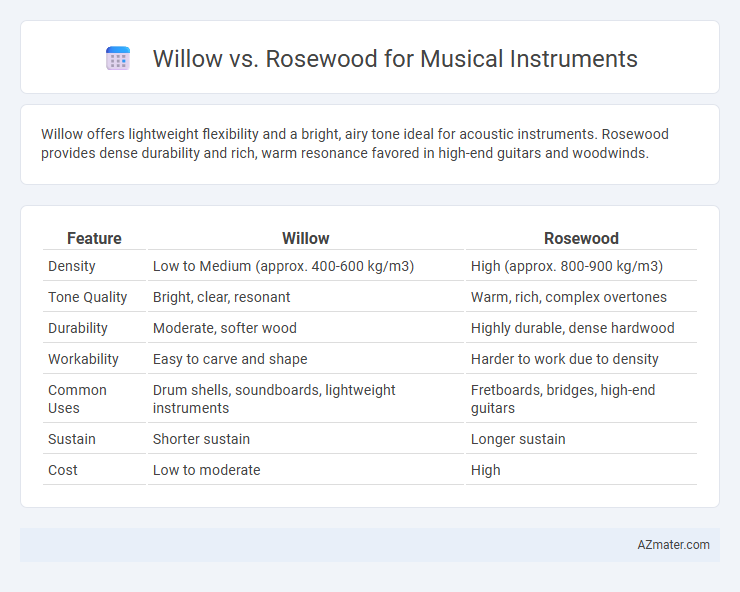Willow offers lightweight flexibility and a bright, airy tone ideal for acoustic instruments. Rosewood provides dense durability and rich, warm resonance favored in high-end guitars and woodwinds.
Table of Comparison
| Feature | Willow | Rosewood |
|---|---|---|
| Density | Low to Medium (approx. 400-600 kg/m3) | High (approx. 800-900 kg/m3) |
| Tone Quality | Bright, clear, resonant | Warm, rich, complex overtones |
| Durability | Moderate, softer wood | Highly durable, dense hardwood |
| Workability | Easy to carve and shape | Harder to work due to density |
| Common Uses | Drum shells, soundboards, lightweight instruments | Fretboards, bridges, high-end guitars |
| Sustain | Shorter sustain | Longer sustain |
| Cost | Low to moderate | High |
Introduction to Willow and Rosewood in Musical Instrument Construction
Willow and rosewood are both notable woods used in musical instrument construction, valued for their distinct tonal qualities and durability. Willow offers a lightweight structure with a soft, warm resonance, often favored in crafting drum shells and acoustic instrument bodies. Rosewood, recognized for its dense grain and rich, complex sound, is commonly used in fingerboards, bridges, and guitar backs, enhancing sustain and tonal clarity.
Botanical and Material Characteristics of Willow and Rosewood
Willow wood, derived from the Salix genus, features a lightweight, soft texture with low density, making it ideal for percussion instruments and drum shells due to its shock-absorbing properties. Rosewood, primarily sourced from the Dalbergia genus, is characterized by its dense, hard, and oily grain structure, providing rich tonal qualities and exceptional durability favored in stringed instruments like guitars and pianos. The botanical differences between willow's fast-growing, flexible fibers and rosewood's slow-growing, tight-grained hardwood directly influence their acoustic resonance and suitability for specific musical applications.
Historical Use of Willow vs Rosewood in Instrument Making
Willow has been traditionally used in early stringed instrument construction for its lightweight and resonant qualities, particularly in parts like the soundboard and internal bracing. Rosewood, favored since the 19th century, is prized for its dense, durable hardwood properties, making it a popular choice for fingerboards, backs, and sides, enhancing tonal richness and sustain. Historical instrument makers often selected willow for its flexibility and rosewood for its strong, beautiful grain, reflecting evolving preferences in sound projection and aesthetics.
Tonal Qualities: Comparing Willow and Rosewood
Willow wood offers a warm, mellow tone with excellent resonance and a smooth midrange, making it ideal for softer, lyrical musical passages. Rosewood is prized for its rich overtones, strong bass response, and bright treble, providing a balanced and dynamic sound preferred in guitars and percussion. Musicians often choose willow for its gentle sound signature, while rosewood's complexity suits genres demanding clarity and projection.
Durability and Stability: Which Wood Lasts Longer?
Willow and rosewood differ significantly in durability and stability when used for musical instruments. Rosewood is renowned for its hardness and resistance to wear, making it ideal for instruments requiring long-lasting resilience, while willow tends to be softer and less dense, leading to quicker wear over time. Musicians prioritizing longevity and structural integrity typically favor rosewood for its superior durability and stable acoustic properties.
Workability and Crafting Ease for Luthiers
Willow offers moderate workability with a softer grain, making it easier for luthiers to carve and shape intricate details, though it may lack the durability of denser woods. Rosewood, known for its hardness and tight grain, presents a challenging crafting experience but rewards with exceptional stability and resonance, favored for fingerboards and bridges. Both woods accommodate fine finishing, yet willow's softness demands careful handling to avoid surface damage during instrument construction.
Aesthetic Differences: Grain, Color, and Finish
Willow wood features a light, creamy color with a fine, straight grain that provides a smooth, subtle texture often favored for a natural, understated finish on musical instruments. Rosewood displays a richer, darker hue ranging from deep browns to purples, with prominent, intricate grain patterns that create a visually striking and luxurious appearance. The finish on willow typically emphasizes its soft, matte qualities, while rosewood benefits from glossy finishes that highlight its complex grain and vibrant color contrasts.
Environmental Impact and Sustainability Concerns
Willow offers a more sustainable option for musical instrument construction due to its rapid growth and regenerative properties, minimizing deforestation risks compared to Rosewood. Rosewood harvesting contributes significantly to deforestation and biodiversity loss, with many species listed on the CITES Appendix II to regulate trade and prevent illegal logging. Choosing willow helps reduce environmental impact by promoting renewable resources, whereas rosewood's scarcity and high demand raise serious sustainability concerns.
Popular Instruments Crafted with Willow and Rosewood
Popular musical instruments crafted with willow include acoustic guitars and percussion instruments, prized for willow's lightweight and resonant properties that enhance sound clarity. Rosewood is commonly used in high-end guitars, violins, and woodwind instruments due to its dense grain and rich tonal warmth, providing superior sustain and depth. Both woods contribute unique acoustic qualities, with willow offering bright, crisp tones and rosewood delivering deep, complex sounds favored by professional musicians.
Choosing the Right Wood: Factors for Musicians and Builders
Willow offers lightweight properties and natural resonance, ideal for acoustic instruments requiring warmth and flexibility, while rosewood provides a denser, harder surface delivering bright tonal clarity and enhanced sustain, preferred in experienced electric guitar construction. Musicians and builders prioritize tonal goals, durability, and aesthetic preferences when choosing between willow and rosewood, considering the wood's grain structure, hardness rating on the Janka scale, and moisture resistance. Environmental sustainability and legal restrictions such as CITES regulations also influence the selection process, with rosewood often regulated more strictly due to overharvesting concerns.

Infographic: Willow vs Rosewood for Musical Instrument
 azmater.com
azmater.com